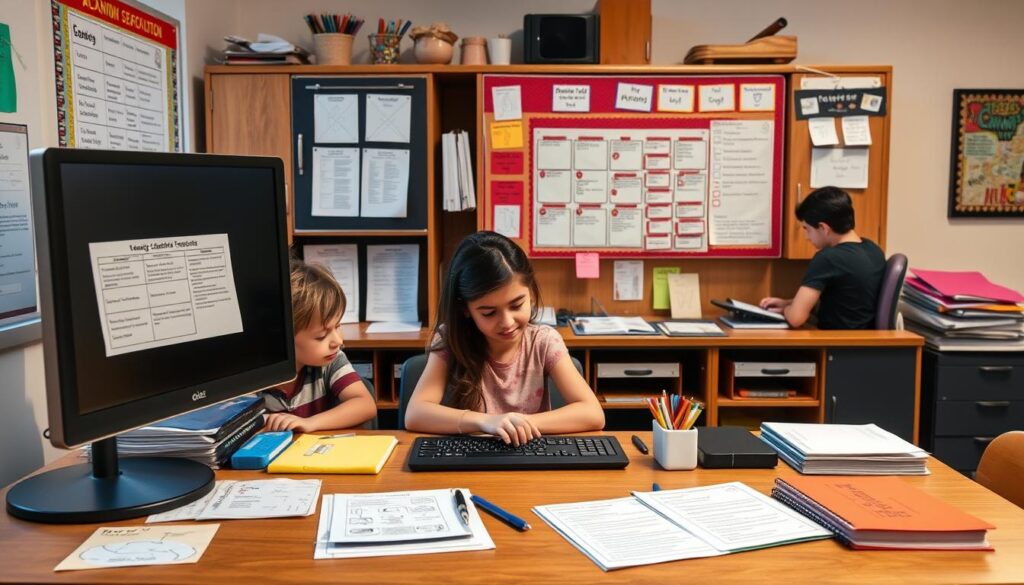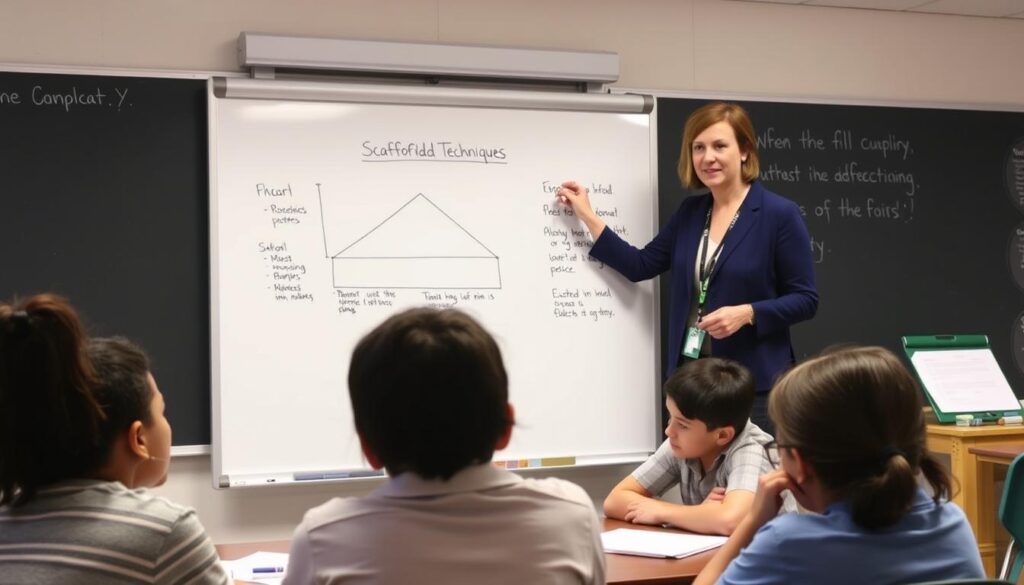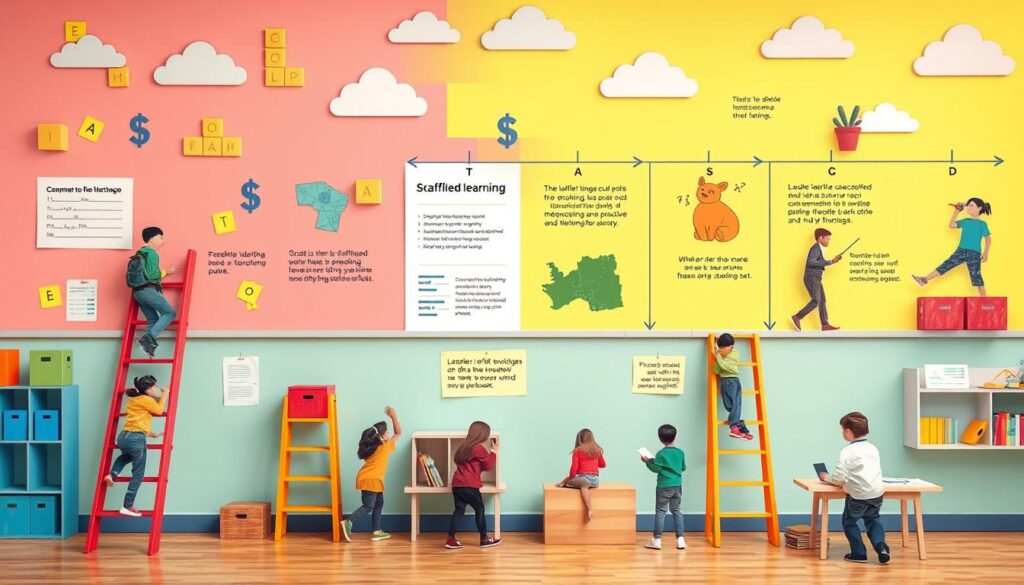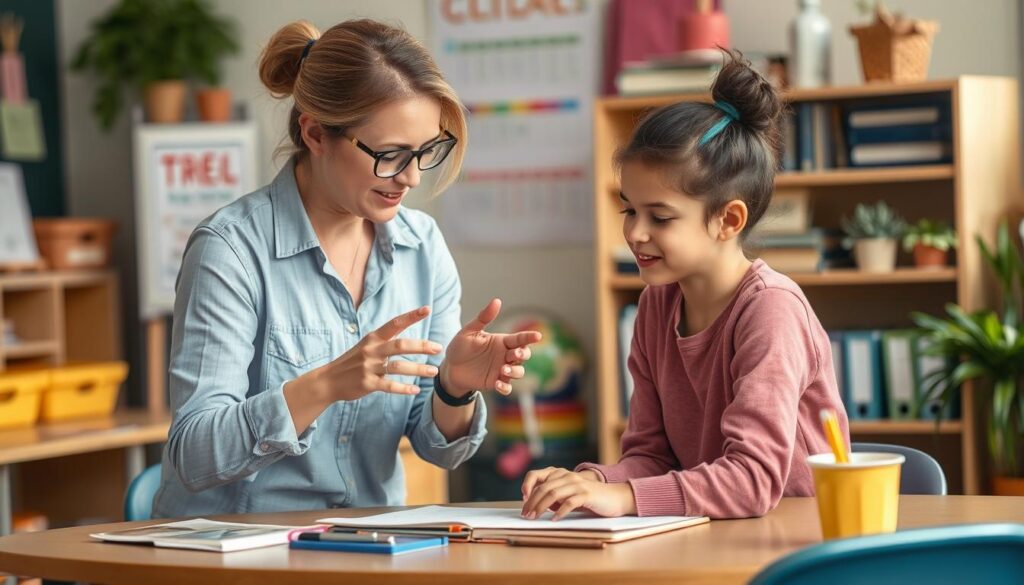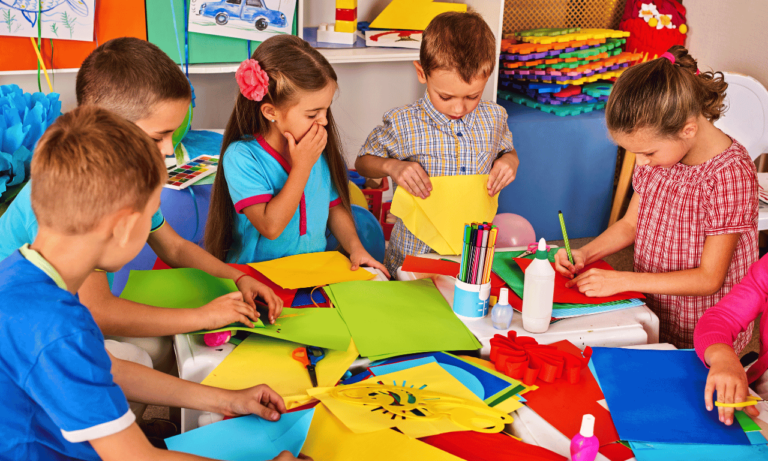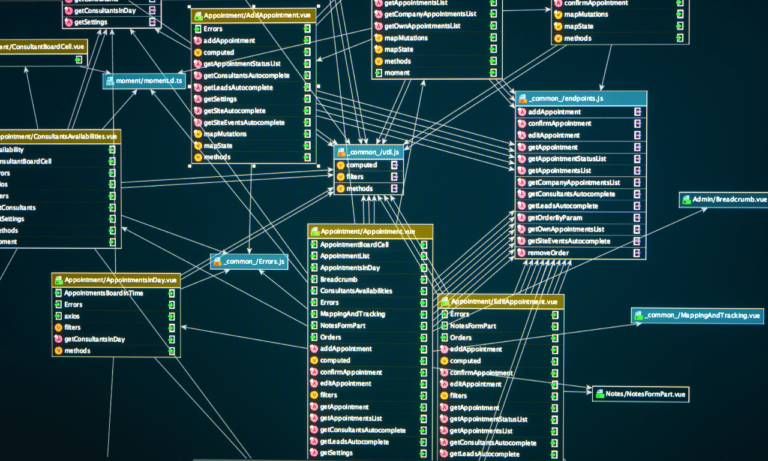Phone:
(+65)8319-0742
Teachers are always looking for new ways to help their students learn. One method that’s really taken off is called instructional scaffolding. It’s about breaking down hard topics into smaller parts and offering extra help. This way, teachers can help students get a solid base in learning and do well in school.
Scaffolding changes the game in the classroom. It lets students face challenges with ease and really get the subject. Teachers use many scaffolding examples like mini-lessons and graphic organizers to make learning fun and supportive.
Using scaffolding, teachers can fill in learning gaps and get students more involved. They can use tools like anchor charts and sentence stems. This method helps students learn step by step, building their skills and knowledge.
Teachers need to keep up with new scaffolding strategies as education changes. From Jerome Bruner’s work in the 1970s to today’s modern methods, scaffolding has changed teaching and learning. By trying out different types of scaffolding, teachers can help students reach their full potential and keep a love for learning.
Key Takeaways
- Scaffolding breaks down complex concepts into manageable chunks, providing targeted support for students.
- Inspiring Classroom Scaffolding includes mini-lessons, read-alouds, graphic organizers, and writing templates.
- Scaffolding bridges learning gaps, increases student engagement, and fosters autonomy.
- The “I Do, We Do, You Do” method is a popular scaffolding technique that gradually releases responsibility to students.
- Adapting scaffolding strategies to unique classroom contexts can unlock the full potential of students and inspire a love of learning.
What is Scaffolding in Education?
In education, scaffolding helps students understand and learn new things. It’s like how tubular scaffolding systems help workers reach high places safely. Educational scaffolding gives students the support they need to learn hard topics and tasks.
Definition of Instructional Scaffolding
Instructional scaffolding is a way teachers help students learn by giving them support. This support can be breaking down hard tasks, giving guidance, and feedback. As students get better, teachers slowly take away the help.
The idea of scaffolding in education started in the 1970s with psychologist Jerome Bruner. He compared it to the temporary structures used in building.
The Importance of Scaffolding in the Classroom
Scaffolding is key in the classroom. It makes a place where students can learn at their own speed. Teachers use scaffolding to help students reach their full potential.
Effective scaffolding helps teachers guide students to success. Some ways to scaffold include:
- Breaking complex assignments into smaller tasks
- Providing guided instruction and modeling
- Offering regular feedback and assessments
- Incorporating technology to support learning
- Adjusting instruction based on assessment results
By using these strategies, teachers create a supportive classroom. This helps students become more engaged, independent, and successful. As they get more confident, they can do things on their own.
Explicit Instruction in Instructional Scaffolding
Explicit instruction is key to effective scaffolding in the classroom. Teachers directly share important info, model skills, and guide practice before students do it alone. Breaking down hard tasks into easy steps helps students learn new skills with confidence.
Studies show explicit instruction helps students with reading, writing, and math. The Council for Exceptional Children calls it a top practice. Using scaffolding tools for classroom learning, teachers make sure all students can participate and succeed.
Systematic Explicit Instruction
Systematic explicit instruction is crucial in education. It includes:
- Introducing the skill or concept
- Modeling the skill or concept
- Providing guided practice
- Offering independent practice
This structured method helps teachers give students more responsibility as they get better. It’s a key part of any teacher’s scaffolding tips for educators toolkit.
Providing Immediate Corrective Feedback
Quick feedback is vital in scaffolding. Teachers correct mistakes during practice to stop students from learning wrong. This feedback helps students improve before they work alone.
Effective feedback is specific, timely, and actionable, providing students with clear guidance on how to improve their performance.
Immediate feedback helps students stay on track and master skills faster. It boosts learning outcomes, confidence, and motivation by making students feel supported.
| Teaching Behavior | Description |
|---|---|
| Clear Expectations | Providing students with a clear understanding of what they will learn and be able to do |
| Brief and Precise Instructions | Delivering concise, easy-to-follow instructions that minimize confusion |
| High Structure | Organizing lessons in a logical, sequential manner that supports learning |
| Connecting New Learning to Previous Learning | Helping students build upon existing knowledge and skills for deeper understanding |
By using these teaching behaviors, educators create a supportive environment for student success. These strategies, along with other scaffolding tips, help teachers bring out the best in their students, no matter their abilities or background.
Examples of Scaffolding in the Classroom
Scaffolding in the classroom helps students learn new things. Teachers use it to make a supportive place for growth and independence. Here are some ways teachers can use scaffolding in their classes.
Mini-Lessons
Mini-lessons are short, focused lessons that target a specific skill or concept. They last 10-15 minutes, giving every student a chance to learn and master a skill before moving on. This method breaks down hard topics into smaller parts, making learning easier for students.
Read-Alouds
Read-alouds help teachers model fluent reading for students. By reading aloud, teachers show students how to pace, intone, and express themselves while reading. These sessions also introduce new vocabulary and complex sentences, helping students understand stories better.
Think-Alouds
Think-alouds let teachers share their thought process while doing a task. This helps students see how to think critically and solve problems. By showing their thought process, teachers help students develop their own thinking skills, making them more independent.
Checklists and Rubrics
Checklists and rubrics guide students through tasks with clear steps and expectations. They help students stay organized and on track. By using these tools, students can check their progress and make sure they meet the requirements. As they get better, they can do tasks on their own.
Anchor Charts
Anchor charts are visual aids that highlight key information on a topic. They help students remember important concepts and steps. Making anchor charts with students uses their knowledge and builds on it, making them more engaged. These charts are useful in many subjects, from reading to math and science, making them a great resource for teachers.
Graphic Organizers
Graphic organizers are tools that help students organize information visually. They come in different forms, like Venn diagrams or flow charts, each suited for different learning styles. These organizers help students break down complex ideas, see relationships, and understand material better. They’re especially good for visual learners and can be used in many subjects and at various grade levels.
Scaffolding is the support given during the learning process which is tailored to the needs of the student with the intention of helping the student achieve his/her learning goals. – Sawyer, R. Keith. The Cambridge Handbook of the Learning Sciences. New York: Cambridge University Press, 2006.
Using these scaffolding examples, teachers can make a supportive classroom that challenges and guides students. As students get more confident and skilled, teachers can slowly remove the scaffolding. This lets students become independent, self-directed learners.
Scaffolding Strategies for Teachers
As educators, it’s key to have many scaffolding instruction techniques ready. These strategies help students learn new skills and concepts by offering support that slowly fades away as they get better. Here are some effective scaffolding strategies to use in your classroom:
Pre-Teaching and Activating Prior Knowledge
Before starting a new topic, review important background knowledge your students already know. This helps them connect what they know with what they’re learning. Also, teaching key vocabulary in familiar topics helps students understand and remember new info better.
I Do, We Do, You Do
This strategy has three steps. First, the teacher shows a skill or concept (I Do). Then, the class practices it together with the teacher’s help (We Do). Finally, students do it on their own (You Do). This way, students gain confidence and skill over time.
“Scaffolding enables children to perform at a higher level than they would on their own, whether while counting, sorting, creating plans, or engaging in different activities.” – Jerome Bruner
Sentence Stems and Writing Templates
Using sentence stems and writing templates is a great way to help students with writing. These tools guide them through the structure of specific assignments, like persuasive essays or research papers. As they get better, they can stop using the templates and write on their own.
| Scaffolding Strategy | Description | Benefits |
|---|---|---|
| Pre-Teaching and Activating Prior Knowledge | Reviewing background knowledge and pre-teaching key vocabulary | Helps students make connections and understand new concepts better |
| I Do, We Do, You Do | Teacher demonstrates, class practices together, students practice independently | Gradual release of responsibility builds confidence and mastery |
| Sentence Stems and Writing Templates | Tools that guide students through the structure and organization of writing assignments | Supports the writing process and helps students write independently |
Using these types of scaffolding in education, teachers can create a supportive learning space for all students. The goal of scaffolding is to slowly remove support as students get better, encouraging independence and a love for learning.
The Zone of Proximal Development and Scaffolding
The Zone of Proximal Development (ZPD) and scaffolding are key ideas in education. They help students learn better. Lev Vygotsky introduced the ZPD. It shows the gap between what a student can do alone and with help from a teacher.
This idea helps teachers see what each student needs. They can then use effective scaffolding methods to help students reach their full potential.
Scaffolding means giving students the support they need to do tasks they can’t do alone. Teachers break down hard topics, guide students, and then slowly step back. This helps students move through their ZPDs.
A study shows how important these ideas are for learning together.
Each student’s ZPD is different, even if they are at the same level. Things like what they know, how they learn, and their past experiences affect their growth. Teachers should check on students often and adjust their help to keep it right.
“The distance between what children can do by themselves and the next learning that they can be helped to achieve with competent assistance.” – Eileen Raymond, on the Zone of Proximal Development
Good scaffolding also means working together with students. Teachers need to understand where students are and what they need. This helps teachers give the right support. They use clues from students to help them move forward.
| Scaffolding Strategy | Description | Benefits |
|---|---|---|
| Activating Prior Knowledge | Connecting new concepts to existing knowledge | Fills gaps in understanding and boosts confidence |
| Breaking Lessons into Segments | Dividing complex tasks into manageable parts | Enhances engagement and retention |
| Allocating Processing Time | Providing time for reflection and consolidation | Increases retention and engagement |
| Group Work | Fostering collaboration among learners at different ZPD levels | Allows learners to assist each other |
By using the Zone of Proximal Development and scaffolding, teachers can make learning supportive for everyone. As students move through their ZPDs, they learn more and become more independent. They gain the skills and confidence to handle harder challenges on their own.
Benefits of Scaffolding in the Classroom
Scaffolding has been a key part of education for a long time. It breaks down hard topics into easier parts. This helps students build on what they already know, making new info stick better.
This method also helps students link new ideas to what they already know. It builds a strong base for learning that lasts. This makes learning more effective and lasting.
Scaffolding makes students more engaged and independent. It gives them the support they need for tough tasks. This lets them take charge of their learning.
As students see their progress, they gain confidence and independence. This confidence helps them in all areas of life. It leads to better grades and a positive view of learning.
Scaffolding is great for helping students with hard subjects. It breaks down complex ideas into simpler steps. This reduces frustration and helps students move forward.
This is very helpful for students who have found certain subjects hard before. It gives them the support they need to do well. By using scaffolding best practices, teachers can make learning fair and effective for everyone.
Improved Retention of New Information
Keeping information in students’ minds is a big goal in education. Scaffolding is a strong tool for this. It connects new ideas to what students already know.
This makes understanding easier and builds a solid base for more learning. It’s very useful for students who find it hard to follow lectures. It gives them the support they need to understand new concepts.
Increased Student Engagement and Autonomy
Scaffolding also makes students more engaged and independent. It gives them the tools and support for hard tasks. This lets them take charge of their learning.
As students see their progress, they become more confident and independent. This confidence helps them in all areas of life. It leads to better grades and a positive view of learning.
Teachers can help this by giving clear expectations and feedback. They should slowly give more responsibility to students as they get better.
Bridging Learning Gaps
Scaffolding is great for helping students with hard subjects. It breaks down complex ideas into simpler steps. This reduces frustration and helps students move forward.
This is very helpful for students who have struggled with certain subjects before. It gives them the support they need to succeed. By using scaffolding best practices, teachers can make learning fair and effective for everyone.
FAQ
What are some effective scaffolding strategies for teachers?
Teachers can use pre-teaching and activating prior knowledge to help students. The “I Do, We Do, You Do” method is also effective. Providing sentence stems and writing templates is another way to support learning.
How can scaffolding improve student engagement and autonomy?
Scaffolding makes learning more engaging for students. It helps them track their progress and become more independent. With a structured approach, students feel confident and motivated to learn more.
What are some examples of scaffolding activities for students?
Mini-lessons and read-alouds are great scaffolding activities. Think-alouds, checklists, and rubrics also work well. Anchor charts and graphic organizers make complex ideas easier to understand.
How does scaffolding relate to the Zone of Proximal Development (ZPD)?
Scaffolding helps students move through their Zone of Proximal Development (ZPD). It provides support to bridge the gap between what they can do alone and with guidance. This approach helps students reach new levels of understanding and mastery.
What are the benefits of using scaffolding in the classroom?
Scaffolding has many benefits in the classroom. It improves how well students remember new information and keeps them more engaged. It also helps students work more independently and fills learning gaps.
It makes communication between teachers and students better. Plus, it keeps classes running smoothly.

Protection Scaffolding: Ensuring Site Safety
Safety is of paramount importance when working at height, and proper protection scaffolding is crucial…

Curriculum Scaffolding Techniques for Educators
Enhancing the educational experience for students involves a delicate balance of effective teaching methods,…

Aluminum vs Tube Couplers: Secure pros and cons
Choosing the right material for tube coupling is key in many industries. The comparison of aluminum vs…

Essential Scaffold User Training Components
Scaffold user training is key to keeping workers safe and following the law in construction. Good training…

OSHA Standards: Sources and Exceptions
The Occupational Safety and Health Administration (OSHA) works to make sure workplaces are safe for everyone….
No posts found


